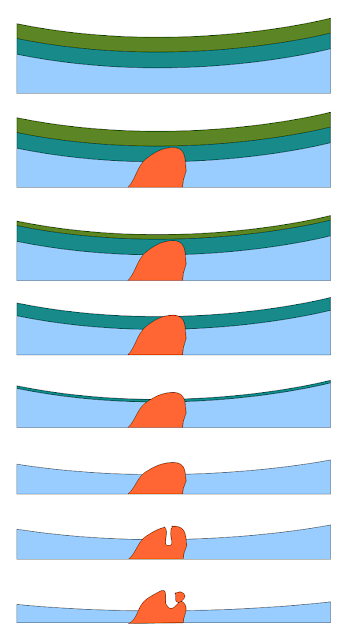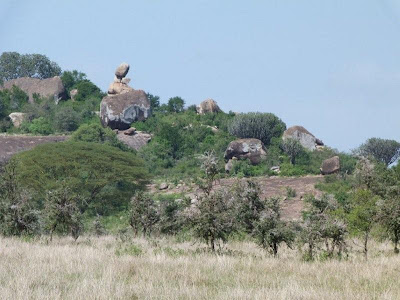The formation of kopjes, the iconic rock formations of the Serengeti, is a geological process that spans hundreds of millions of years. These striking granite outcrops are the result of a combination of volcanic activity and gradual erosion. Below is a detailed step-by-step guide on how kopjes form, using insights from geology and the Serengeti landscape:
Overview of Kopjes Formation
Kopjes, the striking granite outcrops dotting the vast Serengeti plains, are not only iconic landscape features but also key ecological hubs in the region. These rock formations have a deep geological history, their origins tracing back to the Precambrian Era, more than 540 million years ago.
During this ancient time, immense tectonic forces caused molten rock (magma) to push upward from the Earth’s mantle into the crust. As the magma cooled and solidified beneath the surface, it formed vast expanses of granite. Over the millennia, this granite lay hidden beneath layers of softer volcanic rock and ash that covered much of the Serengeti, deposited by volcanic activity.
However, the more recent geological processes of erosion, especially by wind and rain, slowly wore away the upper layers of softer material. Over millions of years, these forces revealed the older, harder granite beneath. What remains are the kopjes, the resilient rocky outcrops that stand above the otherwise flat plains, showcasing the dramatic results of natural erosion over deep time.
Step-by-Step Process of Kopje Formation in the Serengeti
1. Precambrian Beginnings: Formation of Ancient Rock Layers
- Step 1: Africa’s ancient geological history began over a billion years ago. During this time, the surface of the continent was predominantly made up of old rocks, including soft sedimentary rocks like sandstones and mudstones.
- Step 2: Over time, tectonic forces caused mountains to rise and erode, filling valleys, plains, lakes, and seas with sediments. These layers eventually compacted and solidified into sedimentary rock.
2. Intrusive Volcanic Activity: Magma Pushing Upwards
- Step 3: During subsequent volcanic events, molten rock, or magma, was forced upward from deep beneath the Earth’s crust. However, unlike erupted lava, this magma did not reach the surface.
- Step 4: The magma cooled slowly underground, forming a hard, dense rock called granite (or sometimes gneiss, a metamorphic rock). This granite intrusion became embedded within the surrounding softer sedimentary rock layers. At this point, the landscape still appeared relatively smooth and uninterrupted.

3. Initial Erosion: Gradual Wearing Away of Softer Rocks
- Step 5: Over millions of years, natural weathering processes like wind and rain gradually eroded the overlying layers of softer rock (sandstones and mudstones).
- Step 6: The erosion of these softer rocks occurred faster than that of the much harder granite beneath. This differential erosion eventually exposed the top of the granite intrusion at the surface.
4. Exposure of Granite: Kopjes Begin to Take Shape
- Step 7: As more of the softer surrounding rock was worn away, the granite, being more resistant to erosion, remained, forming the initial shape of a kopje.
- Step 8: Over time, natural cracks and weaknesses in the granite began to appear, leading to the creation of tors—piles of stacked rocks that are characteristic of many kopjes in the Serengeti.
5. Formation of Classic Kopjes: Stacked Granite Tors
- Step 9: With continued erosion, both the surrounding soft rocks and the harder granite wore down, but the rate of erosion for the granite was much slower. Over millions of years, the process of splitting and weathering of the granite created the classic stacked formations of rocks seen today in the Serengeti.
- Step 10: Some kopjes, like those found in the Moru region of the Serengeti, display particularly impressive tors, with distinct piles of large, smooth rocks resting on top of each other. These rock piles are often used by wildlife for shelter and vantage points.
6. Ongoing Erosion: The Kopjes Continue to Evolve
- Step 11: Even today, erosion continues to shape the kopjes. While the granite itself erodes at an extremely slow pace, wind, rain, and temperature fluctuations slowly chip away at the rocks, altering their shape over time.
- Step 12: As erosion continues, some kopjes may eventually break down into smaller rock formations, though this process could take millions of more years.
Geological Significance of Kopjes
Kopjes are not only a result of volcanic intrusions and erosion but are also remnants of Africa’s deep geological past. They provide a rare view into the Earth’s interior, revealing rocks that formed far below the surface. The granite (or gneiss) exposed in kopjes is extremely old, often dating back over 550 million years, while the surrounding rock layers can be over 1.2 billion years old.
Ecological Importance of Kopjes
Kopjes play a vital role in the Serengeti ecosystem. Their rocky structures provide shelter for a variety of species, from small reptiles and birds to large predators like lions and leopards. Kopjes also serve as lookout points for animals seeking to survey the surrounding plains for prey or predators.
In the otherwise flat landscape of the Serengeti, kopjes act as micro-habitats, supporting unique flora and fauna that cannot survive on the open plains. The crevices between rocks trap water and provide cooler, shaded environments, making kopjes critical ecological refuges in an often harsh and arid environment.
Summary of Kopje Formation
The kopjes of the Serengeti are ancient geological formations created through millions of years of volcanic activity and erosion. Starting with volcanic magma pushing up through softer sedimentary rock, granite intrusions eventually became exposed as the softer surrounding rocks eroded away. Over time, the hard granite split into tors, forming the iconic stacked rocks seen today. These formations continue to evolve, shaped by ongoing erosion, and they remain vital to the Serengeti’s unique ecosystems.

